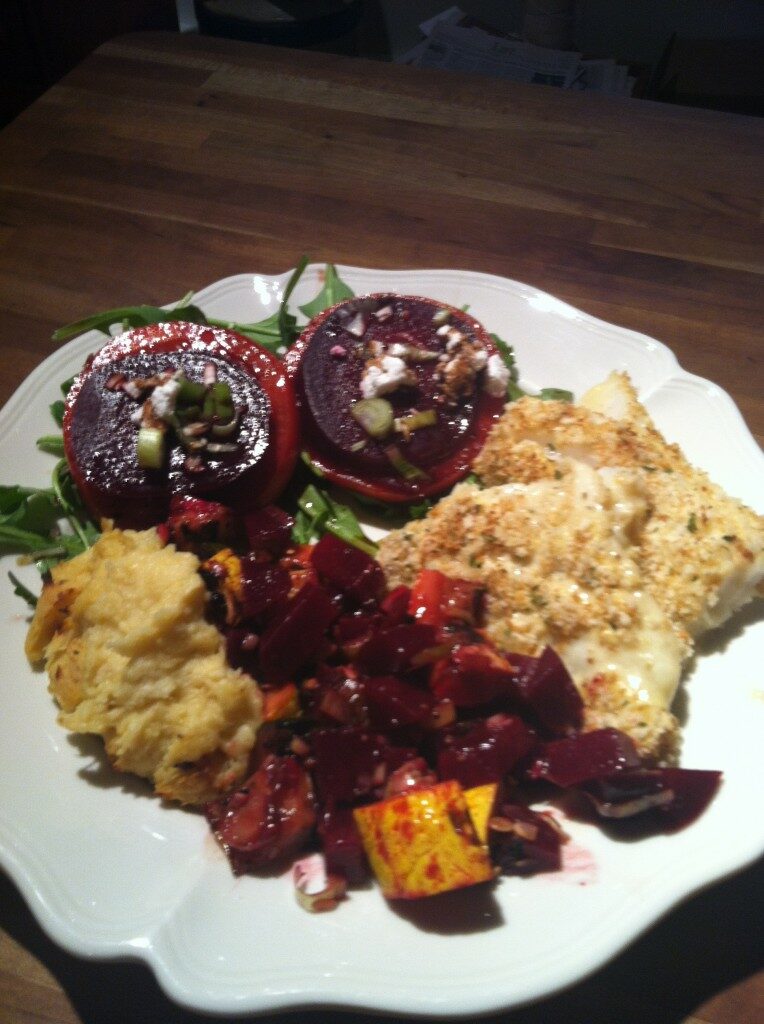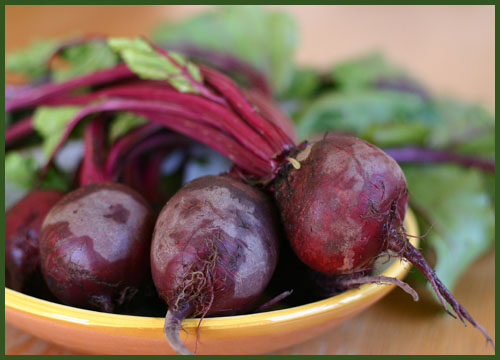Variety is an important component to maintaining a healthy and nutrient-dense diet. But, cooking unfamiliar foods can be intimidating. On the other hand, re-introducing foods that we thought we didn’t like as kids or younger adults may not be appealing.
Over the course of the past decade, John and I have gradually evolved our eating in a way that now privileges whole foods (i.e., unprocessed), vegetables, fruits, beans, and the occasional lean protein source. We are frequently asked about healthy food options, and have shared general principles and specific recipes with our friends, family and athletes.
Here, we’d like to introduce the inclusion of a semi-regular feature that will focus on a a particular food, it’s benefits, and some recipes for preparing it and including it in your daily diet. If there is a particular food you’d like us to include in the future, send us a message on Twitter, Facebook, or via email.
We are starting the series with one of our favorite foods: Beets. When I was a child, this was NOT one of my favorite foods, but within the past few years, I re-discovered them, and found that they are deliciously sweet, earthy and versatile. They can be prepared in a variety of ways, and their list of health benefits is impressive.
Eat your beets – they are good for you!
That deep, rich color of beetroot is telling of the varied nutritional properties that lie within this delectable root. Beets are rich in anti-oxidant and anti-inflammatory micronutrients, which promote cardiovascular health and prevent certain types of cancer.
Beets are nutrient-dense, including important vitamins and minerals such as iron, calcium, manganese, phosphorous, Vitamin C, niacin, folic acid, and beta-carotene. Furthermore, beets are high in fiber, which is particularly good for our digestive tract. Beets offer cleansing properties, particularly for purifying blood and the liver. But be careful, for some people too much can cause belly cramping, particularly high intake of straight beetroot juice. (Yes, I learned this the hard way.)
Beets also offer a significant health benefit for endurance athletes, as a series of studies published since 2009 have found a link between the nitrates contained within beets and expanded endurance performance. In a study of cyclists, researchers at the University of Exeter found that drinking 500 ml of beetroot juice for 6 days increased the length of time the cyclists could perform by 16%. The authors theorize that the nitrates reduce the amount of oxygen consumption needed to exercise, which in turn increases the time the fatigue.
Additionally, beets are low calorie, but with quite a bit of slow-digesting sugars, which is different (read: better) from processed sugar. This makes them a healthy energy source that will fuel your efforts without filling out your waistline.
Eat your beets – they taste good too!
While you can buy canned beets, they are so easy to make fresh, that there is no reason to eat the processed variety. When you buy them fresh, you have the added bonus of being able to use the beet greens.
Beets can be prepared in a variety of different ways, including juiced, roasted, steamed, pickled, and sauteed.
In order to juice beets, you will need a heavy duty blender or juicer. We have a Breville juicer, which allows us to juice the beets whole, without parcooking them. If you have a blender or less-heavy duty juicer, you will want to par-cook the beets before juicing them. We recommend mixing in other vegetables or fruits with the beets, such as carrots, kale, lemons, and apples. You can also include a little bit of fresh ginger for an extra zing.
We also include the beet greens in our juices, as well as vegetable smoothies (which we make with the blender).
Roasted Beets
If beet juice or veggie smoothies isn’t your thing, don’t despair. Cooked beets are absolutely scrumptious! In particular, we love roasted beets, which is very simple to make.
Ingredients:
– 3-4 beets
– foil
– olive oil
Directions
Cut the greens from the root. Save the greens for a different application. Place the beets in some foil, sprinkle with some olive oil, and cover with the foil. Place the beets in a 350-degree oven for 30-40 minutes, or until tender. You don’t want the beets to be super-soft, just less firm than they were in their raw state. Be careful not to overcook them, as that will rob them of their nutritional properties.
Once the beets are roasted, you can simply pull the skins off of them. Another option is to peel them before roasting, but it’s really easy to just pull the skins away after they are roasted. This is similar if you steam the beets. However, if you saute the beets, you will want to peel them before cooking them, otherwise the skins will fall off in the cooking process and it will be hard to remove them from your cooked dish.
After roasting (or steaming) the beets, you can do all sorts of things with them.

This plate features beets two ways: In the back, is a roasted beet, summer tomato and arugala salad, topped with scallions, goat cheese and a balsamic drizzle. In the middle/front is roasted beet and summer squash medley. The beets are accompanied by baked cod and a dab of mashed sweet potatoes. This meal can easily be made vegetarian or vegan. Just drop the cod!
Other options include:
- Roasted beet & spring mix wraps. Sliced the roasted beets, lay them in a whole grain wrap (we like the Ezekial wraps), add some spring mix, some goat cheese (or feta or cheese of your liking), drizzle with some balsamic vinaigrette, and enjoy!
- Use roasted beets as an interesting surprise in meat dishes. I’ve made turkey and venison meatloaf with chopped roasted beets. They add flavor and moisture, which is particularly important with low fat proteins.
- Use roasted beets as a base for homemade veggie burgers. Add some mashed beans, seasonings, make into patties – and voila! Homemade veggie burgers. (I recommend baking these burgers, as they are delicate, and don’t withstand grilling or sautéing very well.)
- Eat them all by themselves with some sea salt and balsamic drizzle. What a great mid-afternoon snack that packs the energy you need to finish your day.
A great benefit is that beets are good year-round, so in the winter, when the summer vegetables are a faint memory, beets are a great way add some colorful zip to your plate.
Bon Appetit!
*~*~*~*~*~*~*~*~*~*~*~*~*~*~*~*~*~*~*~*~*~*~*~*~*~
Do you have a recipe for using beets? We’d love to hear it! Drop a note in the comments.

